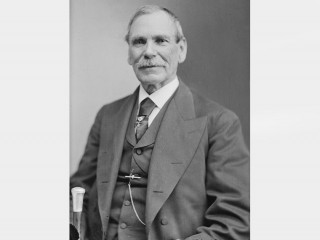
Shields James biography
Date of birth : 1806-05-12
Date of death : 1879-06-01
Birthplace : Altmore, County Tyrone, Ireland
Nationality : Irish
Category : Politics
Last modified : 2010-06-04
Credited as : Politician, Senator from Illinois,
0 votes so far
With the outbreak of the Mexican War he resigned and was commissioned brigadier-general of Illinois volunteers on July 1, 1846. At Cerro Gordo he was dangerously wounded, was brevetted a major-general, and cited by General Scott for his gallant conduct there. At Churubusco, after initial mistakes of some importance (Smith, post, pp. 115-17, 384), he led the charge of New York Irish and South Carolina volunteers that is commemorated in the painting in the national Capitol. In July 1848 his brigade was disbanded, and he returned to Kaskaskia and Belleville to build up his law practice, but he was soon appointed governor of Oregon Territory. This position he resigned immediately to accept an election to the federal Senate. A Whig Senate found a technicality in that he had not been a citizen the required number of years and declared his election void. He, however, was reëlected for the same term and served from Oct. 27, 1849, to Mar. 3, 1855. Martial in carriage, scrupulously neat, urbane and courteous of manner, graceful and humorous in debate, he was well informed because of his ability, experiences, and his command of Latin, French, and Spanish. In temper he was sharp and somewhat arrogantly independent. Something of a demagogue, he was intentionally candid. A strict party man, he had the courage to disagree with fanatics on either side of the slavery issue and to fight for a free California, land grants for veterans, railroad construction, and agricultural education. In 1855 he was defeated for reëlection by Lyman Trumbull in a legislature in deadlock between himself and Lincoln.
A Douglas appointee to distribute Sioux halfbreed scrip, he went to Minnesota Territory, where he settled down on his land grant. He did much to stimulate an Irish movement into the region by organizing the townships of Shieldsville, Erin, Kilkenny, and Montgomery in Lesueur and Rice counties and by establishing with Alexander Faribault the town of Faribault. Elected to the federal Senate, on the admission of Minnesota, he drew the short term that expired Mar. 3, 1859, and a Republican legislature failed to reëlect him. He went to San Francisco, where in 1861 he married Mary Ann Carr, the daughter of an old friend in Armagh, Ireland, by whom he had three surviving children. Settled in Mazatlan, Mexico, as manager and part owner of a mine, he sold his interest and offered his services to Lincoln, when he learned that Fort Sumter had surrendered. Appointed as a brigadier-general of volunteers on Aug. 19, 1861, he campaigned in the Shenandoah Valley, where he won recognition at Winchester and at Port Republic. He resigned his commission on Mar. 28, 1863, and retired to San Francisco, where he was appointed a state railroad commissioner. In 1866, he was in Carrollton, Mo. There he entered politics again, campaigning against the "ironclad oath," losing an election to Congress when a canvassing board cast out the votes of two counties, and supporting the Liberal-Republican candidates of 1872. He lectured for religious, Irish, and charitable causes such as Southern relief during the cholera epidemic. Serving in the legislature, he promoted an act for a railroad commission to which he was afterward appointed. He was elected to fill out an unexpired term in the federal Senate from Jan. 27, 1879, to Mar. 3, 1879, but lack of health forced him to decline being a candidate for reëlection. He died at Ottumwa, Iowa, while on a lecture tour, and was buried with simple Roman Catholic rites at St. MarY&Rsquo;s Cemetery in Carrollton, Mo., where in 1910 a colossal statue was erected to his memory. In 1893 his statue was placed in Statuary Hall in the national Capitol by Illinois and, in 1914, Minnesota, at the insistence of the Grand Army of the Republic, raised a memorial in the state capitol.
















